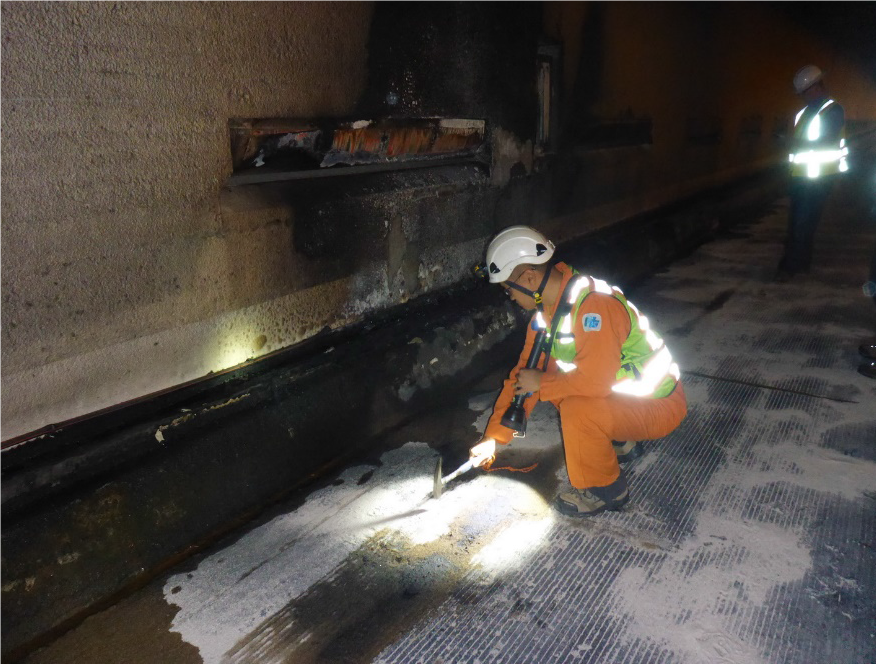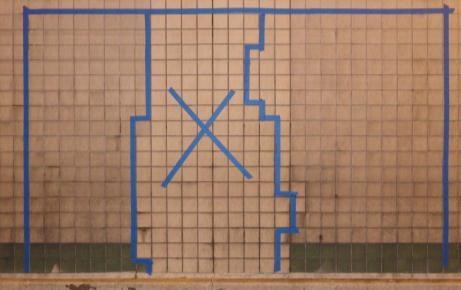Tunnel - Sounding
Target of Investigation
Sounding is a common method of surveying concrete structures for structural evaluation and repair purposes.(1) In tunnels, sounding is used to determine the following:
- The soundness of concrete linings (including determining the presence of delamination, shallow voids, and debonding).(2)
- The extent of each delamination of large horizontal surfaces if a chain drag is used to determine the general locations of delamination.(3)
Description
Different tools can be used to strike the surface of a tunnel wall to determine the soundness of the concrete lining. The impact will produce a high-pitched or ringing sound if the concrete is sound and free of defects. It will produce a dull thud or hollow sound if there is a potential defect below the surface.(4) Although sounding surveys are easy to conduct and require minimal equipment, the process is slow and the results subjective, varying between inspectors. Additionally, inspectors are subjected to working conditions for prolonged periods.(2,5) Because high levels of environmental noise, such as active tunnel traffic, may interfere with the operator’s ability to hear the response, and ladders or other equipment may be required to reach some vertical and overhead locations, traffic control or shutdown is often required.(6,4) Rotary percussion tools that use gear-toothed wheels to produce uniform tapping while rolling along a surface can be mounted on telescoping poles to overcome some height limitations.(4) Sounding can detect late-stage delamination but not early-stage or deep delamination.(5) Hammer sounding is most effective for the top 4–6 inches (10.1–15.2 mm) of concrete.(4) Additionally, this method should not be employed on frozen concrete.(6) Figure 1 shows a worker using hammer sounding to inspect a tunnel after fire damage.
 Source: FHWA.
Source: FHWA. Physical Principle
Hammer sounding is an elastic-wave test method in which the operator strikes the surface and listens to the resulting sound. The presence of a delamination or other defect changes the frequency of oscillations and the audible response of the surface. A clear, ringing sound indicates sound concrete, and a hollow, muted sound indicates a delamination. The hollow sound results from flexural oscillations of the delaminated concrete that create a drumlike effect; this sound is typically in a range of 1–3 kHz, which is within the audible range of the human ear.(2) Sounding can only detect significant delamination and cannot detect early-stage or deep delamination.(5)
Data Acquisition
The standard procedure for hammer sounding on concrete slabs is described in ASTM D4580/D4580M-12, Standard Practice for Measuring Delaminations in Concrete Bridge Decks by Sounding.(6) The steps for general application are as follows:
- Construct a grid system on the surface for ease of plotting delaminated areas that are marked on the surface during evaluation.
- Impact the surface with the hammer; a dull or hollow sound is emitted when delaminated concrete is encountered.
- Outline areas of delamination on the surface.
Data Processing
No data processing is needed, but areas with potential defects are marked on the concrete surface, as shown in figure 2.(6)
 © 2014 TRB.
© 2014 TRB.Data Interpretation
Areas with potential defects, indicated on the surface and maps, can be used for further evaluation of the structure or for the removal and repair of the damaged areas.(1)
Advantages
Advantages of hammer sounding include the following:
- Accurate detection of significant shallow concrete delamination.
- Well-established testing specifications.
- Simple, low-cost equipment.
- Simple procedures for data collection and mapping.
- Effective for initial surveys and repairs.
Limitations
Limitations of hammer sounding include the following:
- Results are subjective.
- Experienced operators are required.
- Traffic control or shutdown are often necessary.
- Environmental noise can adversely affect performance.
- Detection of early or deep delamination is impossible.
- Manual testing is slow.
- Working conditions for inspectors can be unfavorable.
References
- Federal Highway Administration. (2017). “Partial Depth Repairs.” (website) Washington, DC. Available online: www.fhwa.dot.gov/pavement/concrete/repair00.cfm, last accessed January 15, 2019.
- Suda, T., Tabata, A., Kawakami, J., and Suzuki, T. (2004). “Development of an impact sound diagnosis system for tunnel concrete lining.” Tunneling and Underground Space Technology, 19, pp. 328–329, Elsevier, Amsterdam, Netherlands.
- Boyd, S.R. and Frauss, P.D. (2006). Highway Concrete Technology Development and Testing: Volume V – Field Evaluation of Strategic Highway Research Program (SHRP) C‑206 Test Sites (Bridge Deck Overlays), Report No. FHWA-DR-02-086, Federal Highway Administration, Washington, DC.
- Delatte, N., Chen, S., Maini, N., Parker, N., Agrawal, A., Mylonakis, G., Subramaniam, K., et al. (2003). “Application of Nondestructive Evaluation to Subway Tunnel Systems.” Transportation Research Record, 1845, pp. 127–135, Transportation Research Board, Washington, DC.
- Gucunski, N., Romero, F., Kruschwitz, S., Feldmann, R., and Parvardeh, H. (2011). Comprehensive Bridge Deck Deterioration Mapping of Nine Bridges by Nondestructive Evaluation Technologies, Iowa Department of Transportation, Ames, IA.
- ASTM D4580/D4580M-12. (2012). “Standard Practice for Measuring Delaminations in Concrete Bridge Decks by Sounding.” Book of Standards 04.03, ASTM International, West Conshohocken, PA.
- Bergeson, W. and Ernst, S. (2015). Tunnel Operations, Maintenance, Inspection, and Evaluation (TOMIE) Manual, Report No. FHWA-HIF-15-005, Federal Highway Administration, Washington, DC.
- Wimsatt, A., White, J., Leung, C., Scullion, T., Hurlebaus, S., Zollinger, D., Grasley, Z., et al. (2014). Mapping Voids, Debonding, Delaminations, Moisture, and Other Defects Behind or Within Tunnel Linings, Report No. S2-R06G-RR-1, Transportation Research Board, Washington, DC.




